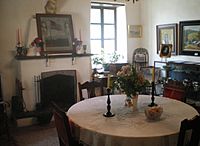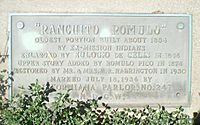Rómulo Pico Adobe facts for kids
|
Rómulo Pico Adobe
|
|

Rómulo Pico Adobe, 2008
|
|
| Location | 10940 Sepulveda Boulevard, Mission Hills, Los Angeles, California |
|---|---|
| Built | 1834 |
| NRHP reference No. | 66000211 |
Quick facts for kids Significant dates |
|
| Added to NRHP | 13 November 1966 |
The Rómulo Pico Adobe is a very old house in Mission Hills, Los Angeles, California. It was built in 1834 and is the oldest home in the San Fernando Valley. This makes it the second oldest house in all of Los Angeles! It is also known as Ranchito Rómulo or Andrés Pico Adobe.
The house was built and owned by the important Pico family of California. It is close to the Mission San Fernando Rey de España. Because of its history, the adobe was added to the National Register of Historic Places in 1966.
Contents
A Glimpse into the Past: The Rómulo Pico Adobe
Building a Historic Home
The first part of the Rómulo Pico Adobe was built in 1834. It was constructed by Native Americans from the San Fernando Mission. These included the Tongva-Fernandeño, Tataviam-Fernandeño, and Chumash-Ventuaño people. The adobe was located right in the middle of the Mission's fruit orchards and vineyards.
At first, the house was just one room, which is now the living room. In 1845, Andrés Pico and Juan Manso leased the Mission lands. Andrés's brother, Governor Pío Pico, granted them this lease. The next year, Governor Pío Pico sold the Mission lands to Eulogio de Celis. This huge area, almost the entire San Fernando Valley, became known as the Rancho Ex-Mission San Fernando. During de Celis's time, the dining room and library were added to the adobe.
From Family Home to Forgotten Treasure
Eulogio de Celis left the property in 1853. He sold half of the Rancho to Andrés Pico. This included the southern part of the Valley, the Mission, and the adobe house. It's not clear if anyone lived in the adobe for the next 20 years.
In 1873, Rómulo Pico and his father Andrés Pico found the house. It was in bad shape because no one had lived there. Rómulo fixed up the adobe. He added a kitchen and two side rooms. He also put wooden floors over the old tile ones. Around 1873, a second story was added. Rómulo lived there with his wife, Catarina Pico, and their family.
Rómulo and Catarina Pico lived at "Ranchito Rómulo" (which means 'Rómulo's Little Ranch') for many years. Later, they moved to Los Angeles. They kept the adobe for overnight stays when they visited the valley. Over time, they rented or sold the house. Eventually, it was left empty. The house started to fall apart. People even broke in, looking for hidden gold!
Bringing the Adobe Back to Life
In 1930, Mark Raymond Harrington bought the abandoned adobe. He was a curator at the Southwest Museum. He worked hard to restore the house. He later wrote about how he fixed the damaged walls and replaced the roof, stairs, and floors. He also added a fireplace to the living room and built a garage.
Visiting the Adobe Today
The City of Los Angeles bought the property in 1965. In 1971, an earthquake damaged the adobe. The city repaired the house. Today, the city's Department of Recreation and Parks takes care of the outside and the grounds.
The San Fernando Valley Historical Society manages the inside of the adobe. They restored it and run a "living museum" there. This means visitors can see what life was like in early California. The adobe is also used for meetings, weddings, and special events. Two popular events are "Rancho Days" in September and Las Posadas before Christmas.
There is also another historic building in the park. It is called the Lankershim Reading Room. This small, eight-sided building is the only part left of the old Lankershim Ranch. The reading room was moved to the park in 2001 and fixed up in 2009–2010.
A Recognized Landmark
The Pico Adobe is recognized as an important historic building at different levels:
- In 1939, it became California Historical Landmark #362.
- In 1962, the City of Los Angeles named it one of its first Cultural-Historic Monuments. It is Los Angeles Historic-Cultural Monument #7.
- In 1966, the adobe was added to the National Register of Historic Places.
- In 2010, the Lankershim Reading Room also became a Los Angeles Historic-Cultural Monument.
See also
 In Spanish: Rómulo Pico Adobe para niños
In Spanish: Rómulo Pico Adobe para niños







